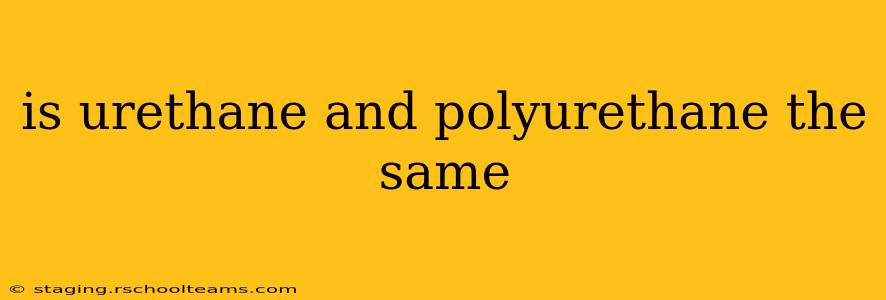The short answer is: no, urethane and polyurethane aren't exactly the same, but they're closely related. The confusion arises because the terms are often used interchangeably, especially in casual conversation. Let's delve into the chemical nuances to clarify the difference.
Urethane: Urethane, chemically known as a carbamate, is a functional group. Think of it as a building block – a specific chemical structure containing a carbonyl group (C=O) bonded to a nitrogen atom (N) and an oxygen atom (O). It's not a material in itself but a component within a larger molecule.
Polyurethane: Polyurethane is a polymer—a large molecule made up of many repeating smaller units. These repeating units incorporate the urethane group as a crucial part of their structure. Therefore, polyurethane contains urethane groups, but it's not simply urethane.
What's the Analogy?
Imagine building with LEGO bricks. The urethane group is like a single LEGO brick. You can't build anything substantial with just one brick. Polyurethane, on the other hand, is like a complex LEGO creation—a car, a house, or a spaceship—made by connecting many urethane "bricks" (and other types of bricks) together in a specific arrangement.
Different Types of Polyurethane: Understanding the Variations
The properties of polyurethane vary dramatically depending on its chemical composition and the way the polymer chains are arranged. This leads to a broad range of applications. These differences arise because the building blocks used to create the polyurethane polymer can be modified and combined in countless ways. This explains the wide diversity of polyurethane products you encounter in everyday life.
H2: What are the common uses of polyurethane?
Polyurethane's versatility is astounding. It's found in:
- Foam: From furniture cushioning to insulation in buildings, polyurethane foams provide excellent thermal insulation and shock absorption. The density and type of foam vary significantly depending on the application.
- Coatings: Polyurethane coatings are highly durable and resistant to abrasion, chemicals, and weathering, making them ideal for protecting surfaces like floors, cars, and industrial equipment.
- Elastomers: These are flexible, rubber-like materials used in things like shoe soles, seals, and gaskets. They offer resilience and durability.
- Adhesives: Many strong and versatile adhesives use polyurethane as a key component.
- Sealants: Polyurethane sealants are used to create waterproof and airtight seals in various applications.
H2: What are the different types of urethane?
While the term "urethane" by itself usually refers to the functional group, there are different types of carbamates (urethanes) which contribute to the overall properties of polyurethane polymers. The precise nature of these carbamates influences the final product. It's not a classification system that gets used commonly in everyday discussions, however.
H2: What is the difference between polyurethane and other polymers?
Polyurethane distinguishes itself from other polymers due to its unique combination of properties: flexibility, strength, durability, resistance to chemicals and abrasion, and excellent insulation capabilities. This versatility allows for its wide range of applications. Compared to, say, polyethylene (plastic bags), polyurethane offers greater strength, resilience, and resistance to harsh conditions.
H2: Is polyurethane toxic?
The toxicity of polyurethane varies greatly depending on the specific formulation and its intended application. Some types of polyurethane foam can release volatile organic compounds (VOCs) which are potentially harmful, especially when the foam is newly manufactured. However, many formulations are designed to minimize or eliminate such emissions. Always check the product's safety data sheet (SDS) for specific information on toxicity and safety precautions.
In summary, while urethane is a fundamental chemical building block, polyurethane is a sophisticated material with diverse applications created by combining and arranging this building block with others. Understanding this distinction helps to appreciate the versatility and significance of this remarkable material.
